Experimental study of the bearing capacity of a drainage pipe pile under vacuum consolidation
Xiao-wu TANG ,Wei-kang LIN ,Yuan ZOU ,Jia-xin LIANG ,Wen-fang ZHAO
1Research Center of Coastal and Urban Geotechnical Engineering,Department of Civil Engineering,Zhejiang University,Hangzhou 310058,China
2Engineering Research Center of Urban Underground Space Development of Zhejiang Province,Hangzhou 310058,China
Abstract: In this study,we propose a drainage pipe pile under vacuum consolidation to integrate foundation treatment and pile foundation engineering in soft soil areas.To study its bearing capacity characteristics and foundation treatment performance,single pile static load tests,vane shear tests,and water content tests were carried out for ordinary piles,perforated piles,and drainage pipe piles under conditions of static and vacuum consolidation.Based on the results,the concept of strong and weak reinforcement areas was proposed and used for bearing capacity prediction.The results showed that the drainage pipe pile did not become silted under vacuum consolidation.The single pile bearing capacity was much higher than that of an ordinary pile,and the pile side friction was exerted mainly in the middle and lower parts.Good results were achieved using the shear strength at the junction of the strong and weak reinforcement areas to estimate the ultimate bearing capacity of a single pile.This study provided important insights into the design and construction of drainage pipe piles in a soft soil foundation.
Key words: Drainage pipe pile;Soft soil;Consolidation;Bearing capacity;Foundation treatment
1 Introduction
The properties of high water content,high compressibility,and low shear strength of soft soil can cause problems in building construction (Li et al.,2020).Soft soil needs to be treated before construction to prevent foundation instability,excessive settlement of structures,or uneven settlement.Preconsolidation with plastic drainage plates before piling is a technique commonly used when dealing with a soft soil foundation.This method effectively reduces excess pore water pressure,soil lateral movement,and pile top settlement (Seed and Reese,1957;Randolph et al.,1979;Pestana et al.,2002;Wu et al.,2006;Mesri,2021;Zhu et al.,2021).However,there are some disadvantages,such as the long drainage consolidation time,difficult degradation of the plastic drainage board,high energy consumption of piling after foundation hardening,and pile foundation deviation caused by a soil squeezing effect (Bergado et al.,2002;Hunt et al.,2002;Indraratna et al.,2005;Sun et al.,2020).
Many geotechnical researchers have explored the mutual benefits of combining foundation treatment and pile foundation engineering.Suleiman et al.(2014) proposed a permeable concrete pile (PCP).Cui et al.(2018) tested the PCP and found that the high permeability of the pile can help the soil drain,but blockage was a potential problem.Zhou and Mei(2014)proposed a perforated pile.Huang et al.(2016)carried out a model test of this kind of pile,revealing the dissipation law of excess pore water pressure of soil around the pile.These two kinds of piles can drain water,but cannot separate water and soil,and silting will occur when they are used in soft soil.Therefore,they are more suitable for sandy soil.Liu et al.(2008) invented a square pile called rigiditydrain pile,which has drainage plates inserted on both sides.Wang(2019)studied its pore pressure response,soil pressure response,and anti-liquefaction performance.The rigidity-drain pile is suitable for soft soil,but due to the grooves on both sides,the friction area was reduced and the pile-soil friction was insufficient when used in a soft soil foundation.
In summary,research on combining foundation treatment and pile foundation engineering has made some progress,but the various methods have certain shortcomings.To further promote the integration of foundation treatment and pile foundation engineering,in this study we propose a vacuum preloaded drainage pipe pile based on the research of Tang et al.(2015,2019a,2019b).This vacuum preloaded drainage pipe pile differs from the pile mentioned above in three ways: (1) Small holes are evenly distributed on the pile body and covered with an anti-clogging geomembrane to avoid hole siltation.(2)The pile bottom is closed,and the pile top is connected to a vacuum pump to accelerate drainage and consolidation.There is no need for pre-consolidation with plastic drainage plates before piling.(3) When the soil is weak,it is driven to reduce the soil squeezing effect.After the soil becomes hard,it can be used directly as an engineering pile.
In this study,single pile static load laboratory tests,vane shear tests,and water content tests were carried out for pipe piles,perforated piles,and drainage pipe piles under conditions of static and vacuum preloading.Based on the results,the variation laws of single pile bearing capacity,pile shaft axial force,and pile side friction resistance of the different pile types under different working conditions were compared and analyzed.The distributions of shear strength and water content at different positions within the soil around the pile were studied.Based on our findings,we propose an improved method for predicting the ultimate bearing capacity of a drainage pipe pile based on the code method (MOC,2008).This can provide some theoretical support for the design and construction of drainage pipe piles.
2 Methodology
2.1 Soil conditions
The clay for the test was taken from the site of Hangzhou Xiecun Wharf,China.Undisturbed soil refers to the natural soil directly excavated from the foundation pit by the excavator and put into the model bucket.To prepare remolded soil with the 80% water content required for the test,firstly,the physical parameters of natural soil were determined and the water content required to increase to 80% water content calculated according to the formula.Then,after adding water,the soil was stirred evenly through the mixer,and after standing for 48 h,stirred again.Finally,the relevant physical parameters of the remolded soil were determined(Table 1).
Table 1 Physical properties of the clay
2.2 Pile models
Three different types of pile models were used in the experiment: a pipe pile,a perforated pile,and a drainage pipe pile (Fig.1).Ni et al.(2017b) and Huang et al.(2016) conducted indoor model tests of perforated piles with plastic model piles including pentatricopeptide repeats (PPR) and polyvinyl chloride (PVC) materials,to study the dissipation law of excess pore pressure in the soil around the pile after pile sinking.Tang et al.(2020) used PPR material for indoor bearing capacity tests,and the bearing capacity and pile shaft axial force trends obtained were in good agreement with the actual project.This proved that the use of PPR material in a model test is effective and reasonable.
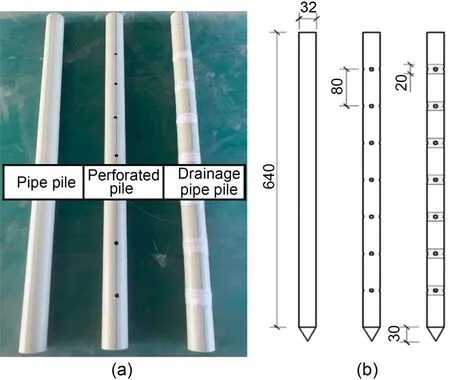
Fig.1 Three different types of pile models(a)and sizes of the pile models(b)(unit:mm)
The three types of piles were simulated by PPR hollow plastic pipes and had the same size,with outer diameterD
=3.2 cm,inner diameterd
=2.4 cm,and heightH
=64 cm.To simulate a C60 concrete pile(the prototype pile had a length of 12 m,an outer diameter of 64 cm,and an inner diameter of 48 cm),the geometric dimension similarity ratio was set to 20.The elastic modulus of C60 concrete was 35 GPa,and the elastic modulus of the PPR material of the model pile was 1 GPa,so the similarity ratio of the pile modulus was 35.Note that the modulus of the model pile used in this test is large considering the holes of the pile body.This will lead to a certain deviation from the scaling laws proposed by Wood (2004).According to the estimation method of Iai (1989),the scaling laws used in the test may lead to the large modulus of theactual pile and underestimation of the compression of the pile itself in the field bearing capacity test.According to Ng et al.(2015) and Bian et al.(2021),when the distance between the pile side and the boundary of the model box exceeds 7 times the pile diameter,the boundary effect can be neglected.According to Kim et al.(2021),this distance is 5 times the pile diameter.Gui et al.(1998) pointed out that applying silicone grease to the pile wall can further reduce the boundary effect.To reduce the boundary effect,a rigid steel barrel with a diameter of 60 cm and a height of 120 cm was prepared.There were many stirrups inside the steel barrel to prevent deformation.The barrel wall was coated with grease to reduce the boundary effect.The distance between the pile side and the steel barrel wall was 8.875 times the pile diameter.The depth of the model barrel(120 cm)was twice that of the pile sinking depth (60 cm).Therefore,the interaction between the pile and the barrel wall could be ignored.
The perforated pile was cross-symmetrically bored around the pile,with four holes in each layer.The diameter of the hole was 6.5 mm.There were seven layers and 28 holes in total.Starting from the pile bottom,layers were spaced 8 cm apart.The drainage pipe pile was formed by wrapping a geotextile with a width of 2 cm around the perforated sections of the pile.The physical parameters of the geotextile are shown in Table 2.
A tapered pile head was welded to the pile before driving the pile.After a circular iron platform was inserted into the pile top,the pile was driven by static pressure.When the pile sinking depth reached 60 cm,pile sinking was stopped and the platform was measured with a level gauge to check whether it was horizontal or not.In this study,six sets of tests were carried out,and the variables were the types and working conditions of the piles(Table 3).
Table 2 Physical parameters of geotextile
Table 3 Grouping of the tests
2.3 Vacuum method
The vacuum system used in the test included a vacuum machine,a three-necked bottle,a vacuum tube,and a rubber plug.An image of the real object is shown in Fig.2a,and the connection mode in Fig.2b.The results of drained volume are shown in Fig.3.During the vacuum process,a sealing film was applied to prevent water evaporation.At this time,settlement occurred on the soil surface,but the amount was small,and due to the presence of the sealing film,the development of the settlement with the vacuum pumping time could not be accurately measured.However,the final settlement of the soil surface at the barrel wall after the end of the vacuum process was 10 mm.
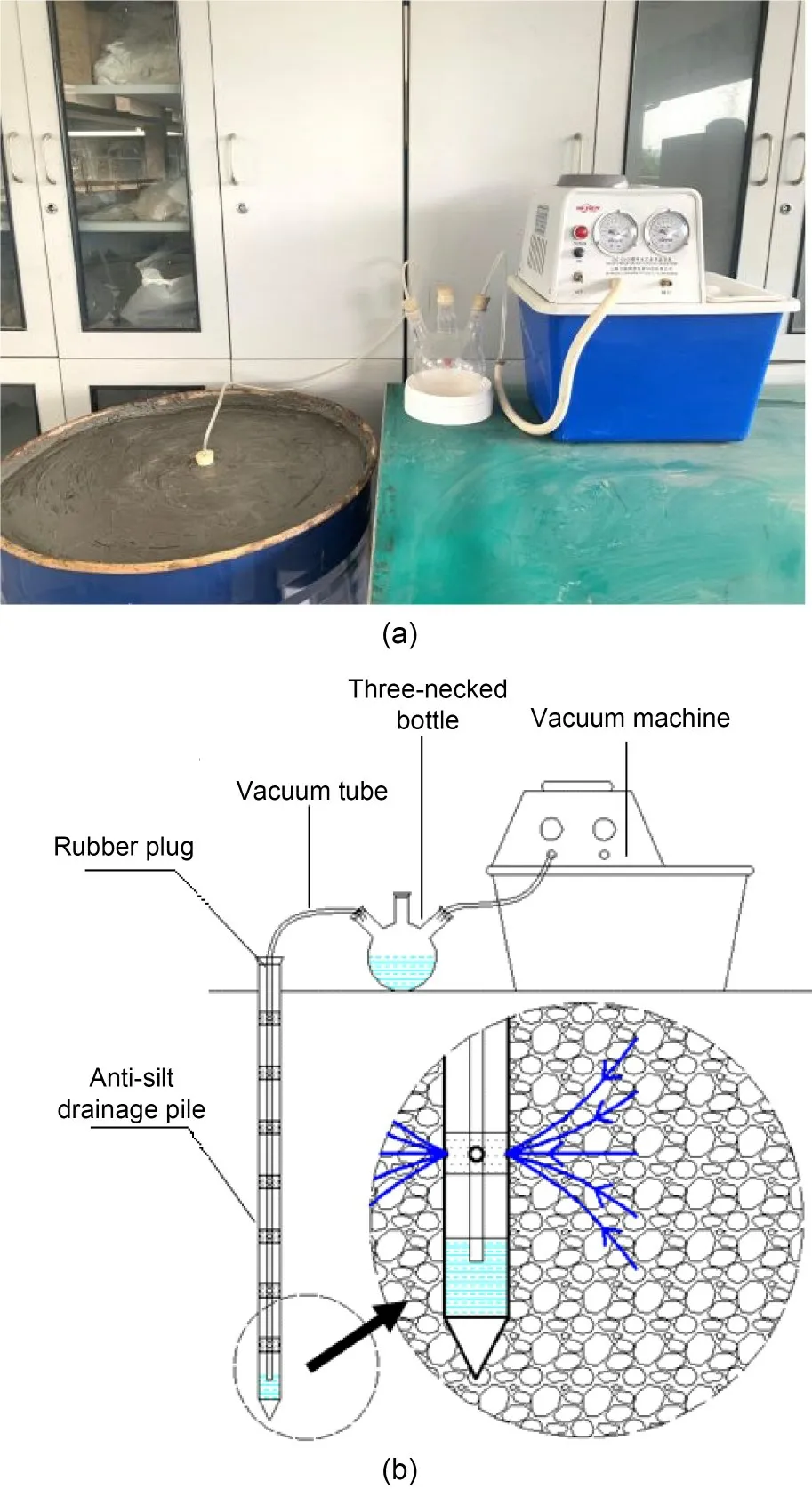
Fig.2 Real object (a) and connection mode (b) of the vacuum system
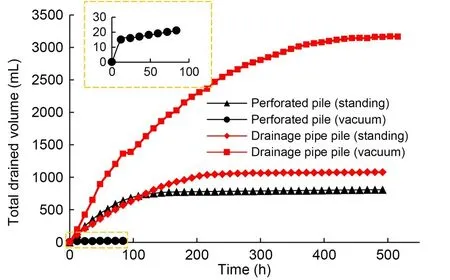
Fig.3 Relationship between total drained volume and time
After 400 h,the drained volume of the drainage pipe pile (vacuum) hardly increased: the total drained volume was 3163 mL.For the perforated pile(vacuum),only a small amount of water was discharged in the first 1-3 h,and the vacuum did not decrease.The small holes in the perforated pile(vacuum) were silted,and so it could not be vacuum consolidated.Therefore,the perforated pile (vacuum)was removed from subsequent tests.Some studies have shown that the excess pore pressure of the soil around the perforated pile dissipates after standing for 65 h (Ni et al.,2017a,2018).The vacuum machine is prone to overheat and shut down after continuous operation for 400 h,and the test results showed that the drainage of each pile did not increase after 350 h.Therefore,the vacuum time in the subsequent test was set to 360 h and the vacuum pressure was maintained at 0.8-0.9 atmospheres.
The influence of vacuum pressure on the bearing capacity and consolidation of the drainage pipe was not considered in this study.However,the relevant research on vacuum preloading drainage boards shows that the greater the vacuum pressure,the better the reinforcement effect.Therefore,in the further field test,it is necessary to ensure the vacuum pressure was greater than 0.75 atmospheres,if possible.
3 Testing program
3.1 Single pile static load tests
The static load test of the vertical bearing capacity of the model pile was carried out using the slow maintenance load method(Fig.4).
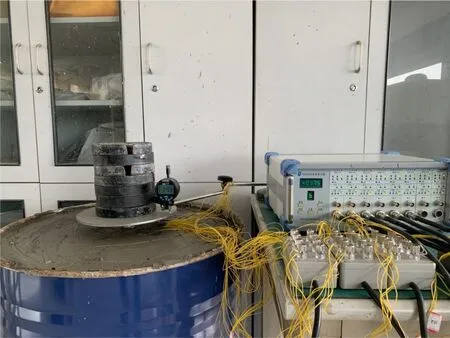
Fig.4 Static load test equipment
The perforated pile and the drainage pipe pile were loaded step by step with a weight of 25 N.The pipe pile was loaded step by step with a weight of 12.5 N.An electronic displacement meter with an accuracy of 0.001 mm was used to measure the displacement of the pile top.A BX120-5AA strain gauge (Beijing Yiyang Strain and Vibration Testing Technology Co.,Ltd.,China) was used to measure the axial force of the pile body.The surface of the strain gauge was coated with room temperature vulcanized (RTV) silicone to prevent water ingress.The pile body was fitted with eight layers of strain gauges.Each layer had four strain gauges,and the spacing of each layer was 6 cm.Fig.5 shows the distribution of strain gauges.
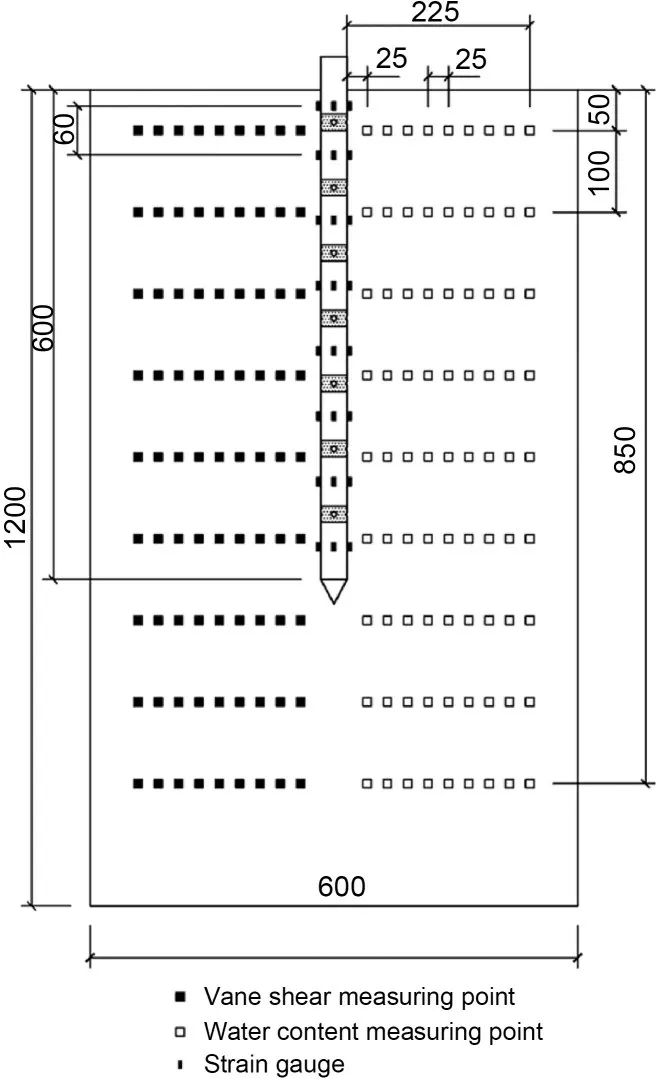
Fig.5 Distribution of measuring points(unit:mm)
3.2 Vane shear and water content tests
To avoid interference in the sampling of the vane shear test and water content test,the measuring points were arranged on the left and right sides of the symmetry axis,as shown in Fig.5.
An Szb-1.0 portable vane shear instrument was used to measure the vane strength.The vane head(diameter=2.5 cm,height=5 cm)refers to the part used to shear the soil during the measurement,as shown in the dashed box in Fig.6.In this experiment,more points could be measured with a smaller vane head.
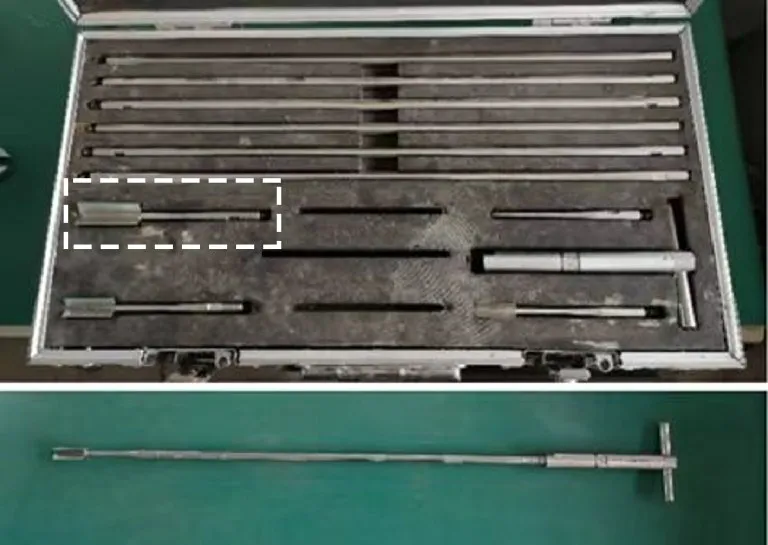
Fig.6 Vane shear instrument
The accuracy was 0.01 kPa,and the test range was 0.1-130.0 kPa.The water content was measured using an oven-drying method.The depth range of vertical measuring points was 5-85 cm,with a spacing of 10 cm.The radial measuring points were 2.5-22.5 cm away from the pile side wall,with a spacing of 2.5 cm.
4 Test results and analysis
4.1 Relationship between pile head displacement and vertical load
Fig.7 shows theQ-S
curve of each group of piles,whereQ
is the load,andS
is the displacement.Each of the five curves has an obvious inflection point,i.e.a steep drop,which is consistent with the static load test characteristics of a single pile in soft clay (Jesmani,2015).Therefore,the load value corresponding to the starting point of the steep drop section of theQ-S
curve was taken as the ultimate bearing capacity.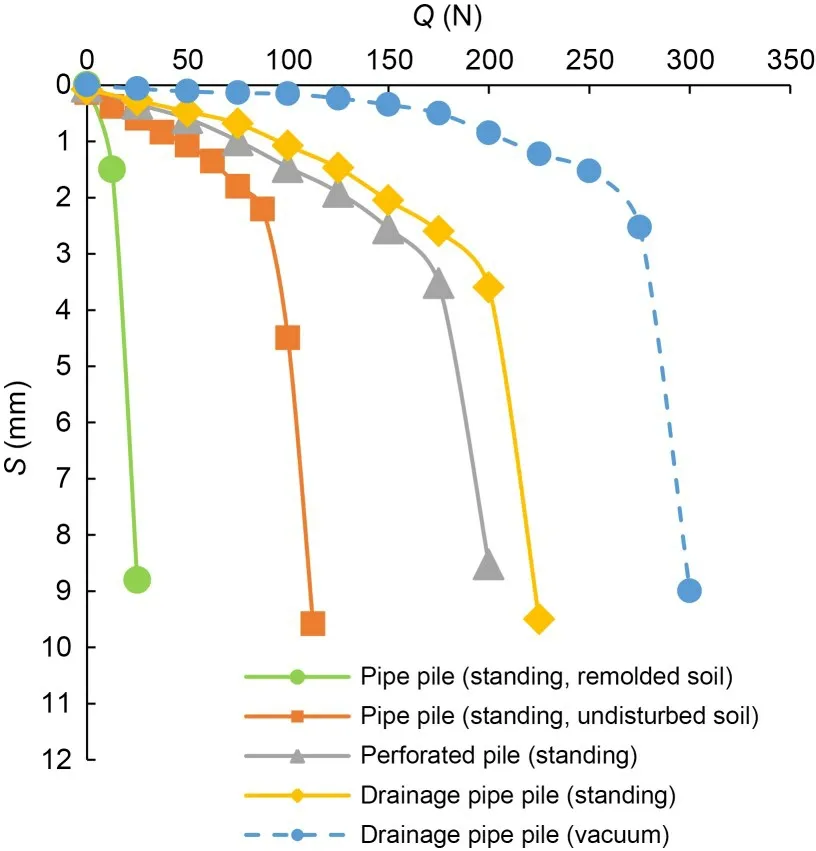
Fig.7 Load-displacement curve for piles
The ultimate bearing capacity of the pipe pile was 89.5 N in undisturbed soil,but only 23.5 N in remolded soil.Therefore,only the pipe pile in undisturbed soil was used as the control group in subsequent tests and analyses.Under vacuum conditions,the ultimate bearing capacity of the drainage pipe pile was 271.5 N,which was more than 3 times the ultimate bearing capacity of the pipe pile.The ultimate bearing capacities of the perforated pile and the drainage pipe pile under static conditions were similar(162.5 and 178.0 N,respectively).The test results show that the drainage channel was conducive to the consolidation and drainage of the soil around the pile.
Therefore,it can improve the ultimate bearing capacity of a single pile to a certain extent.Vacuum consolidation and anti-clogging measures can effectively improve the bearing capacity of a single pile,in which vacuum consolidation plays a leading role.
4.2 Analysis of pile axial force
The distribution of the axial force of the pile body along the depth under the action of various loads during the static load test is shown in Fig.8.The axial force curve of the pipe pile (standing) was steeper than that of other pile types.The pile tip resistance began to have an effect at the initial stage of loading.When the pile top load was small,the axial force distribution trends of the perforated pile (standing) and the drainage pipe pile (standing) were similar.However,with the increase of pile top load,the rate of attenuation of the axial force on the upper part of the perforated pile increased.The axial force of the drainage pipe pile (vacuum) decreased rapidly at the middle and lower parts of the pile,indicating that the side friction in this area bored more upper load.With the gradual increase of pile top load,the attenuation of axial force became more obvious and pile side friction was further developed.Thus,vacuum consolidation makes the pile-soil tighter and improves the bearing performance of the drainage pipe pile(vacuum).
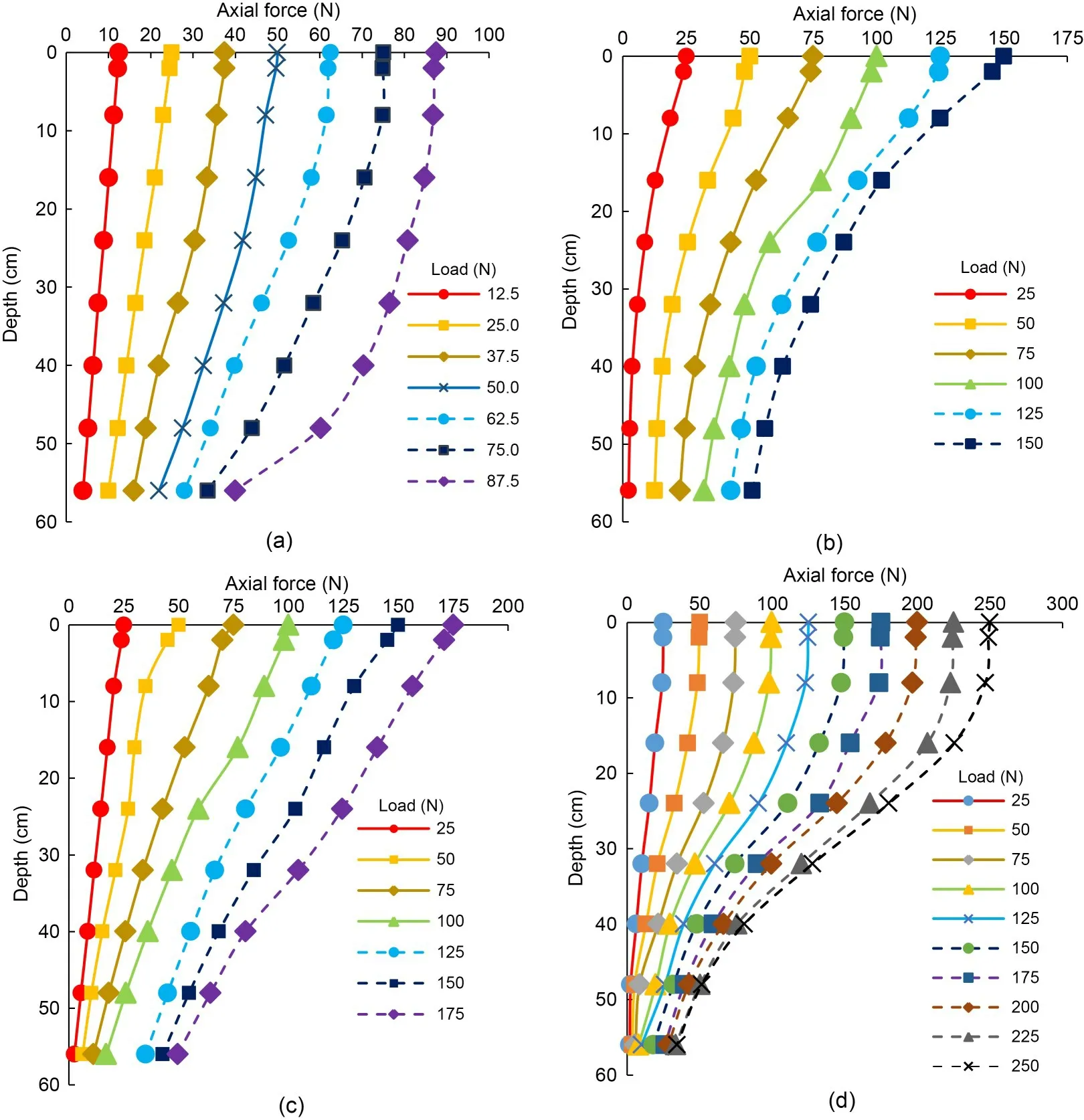
Fig.8 Distribution of the axial force of the pile body along the depth under the action of various loads: (a) pipe pile(standing,undisturbed soil);(b) perforated pile (standing);(c) drainage pipe pile (standing);(d) drainage pipe pile(vacuum)
4.3 Analysis of pile side friction
The pile frictional resistance can be calculated by dividing the difference in section axial force by the side area of the pile body.Fig.9 shows the pile frictional resistance curves of the pipe pile and the drainage pipe pile.
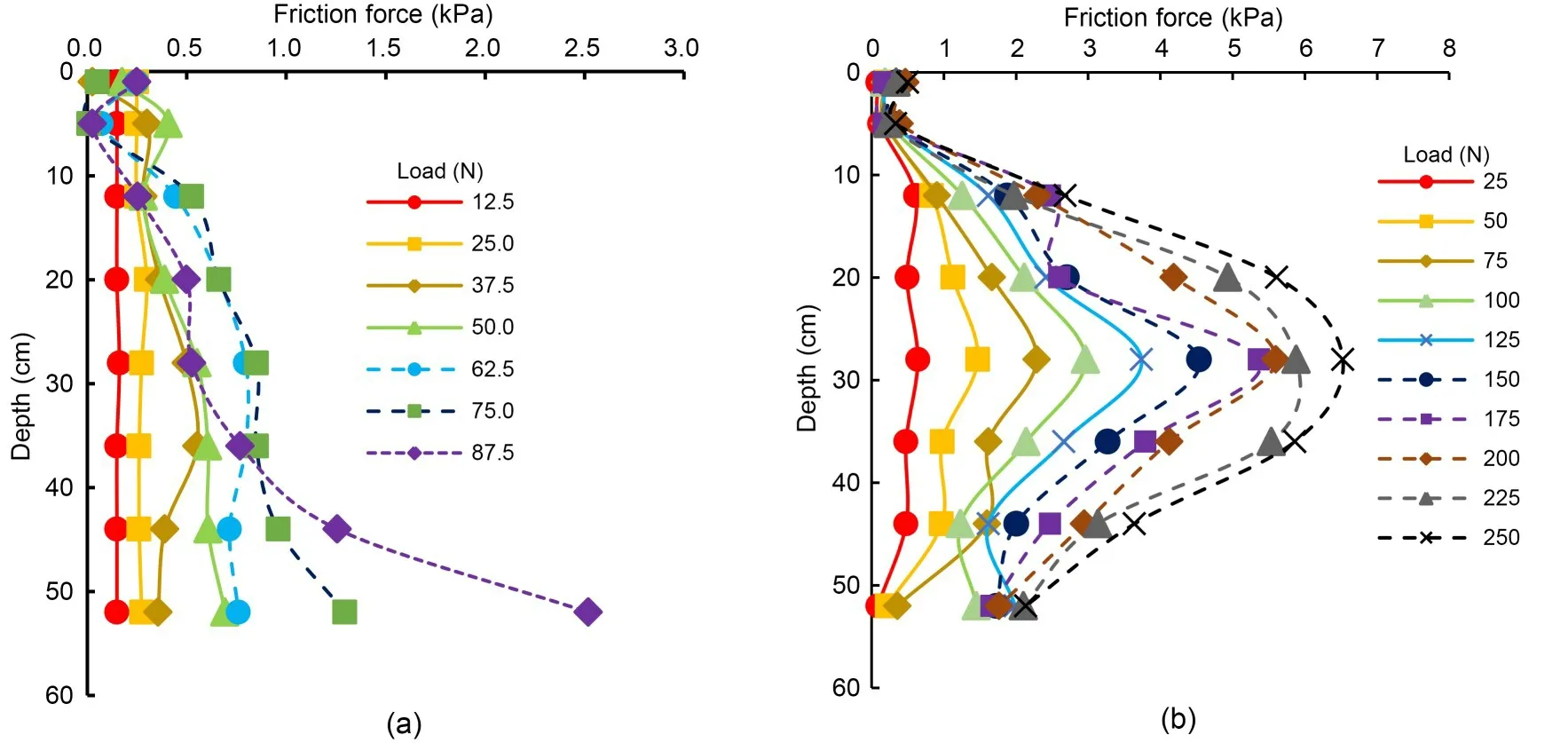
Fig.9 Pile frictional resistance curves of the pipe pile and the drainage pipe pile: (a) pipe pile (standing,undisturbed soil);(b)drainage pipe pile(vacuum)
With the increase of pile top load,the frictional resistance of the pipe pile increased uniformly and slightly with the increasing depth.When it was close to the ultimate bearing capacity,the frictional resistance at a depth of 45-60 cm increased rapidly.When the maximum value reached 2.5 kPa,the pile end resistance decreased rapidly,and penetration failure occurred.
Compared with the pipe pile,the average frictional resistance of the drainage pipe pile (vacuum)under ultimate load increased by 3-4 times.This was mainly because the permeable area of the pile body accelerated the dissipation of excess pore water pressure and improved the effective stress of the soil around the pile.
The frictional resistance distribution of the drainage pipe pile (vacuum) was quite different from that of the pipe pile.The frictional resistance of the drainage pipe pile (vacuum) was large in the middle and small at each end along the depth direction.It may be that vacuum consolidation had more effect in the middle of the pile,making the soil around the pile more compact.
4.4 Analysis of water content distribution
Figs.10,11,and 12a show the water content curves of the perforated pile (standing),the drainage pipe pile (standing),and the drainage pipe pile(vacuum),respectively,at different depths and different distances from the pile wall.The water contents of soil around the perforated pile (standing)and the drainage pipe pile(standing)did not change significantly with the depth.When the depth exceeded the bottom of the pile,the water content increased significantly,making it difficult to drain the soil at the pile bottom by the soil squeezing effect alone.At the same depth,the water content increased with the increase in distance from the pile wall.The minimum water content of the soil 2.5 cm from the pile wall of the perforated pile (standing)was 57.2%,while that of the drainage pipe pile(standing) was 53.5%.The water content of the soil around the drainage pipe pile (vacuum) at a distance of 2.5 cm from the pile side and a depth of 35-45 cm decreased to about 45.0%.This indicates that vacuum consolidation can accelerate the drainage of the soil around a pile and have an obvious effect at the center of the pile.

Fig.10 Water content curves of the perforated pile(standing)
To show the change of water content in space more intuitively,a linear interpolation method was used to show the water content in different parts of the soil in the form of a cloud diagram (Fig.12b).The maximum horizontal range of influence of the drainage pipe pile(vacuum)on soil moisture content around the pile was 10.0-12.5 cm.The water content of the soil after the drainage pipe pile (vacuum)treatment began to increase significantly when the depth was more than 75 cm.This indicates that vacuum consolidation can help drain the soil,even at the bottom of the pile.
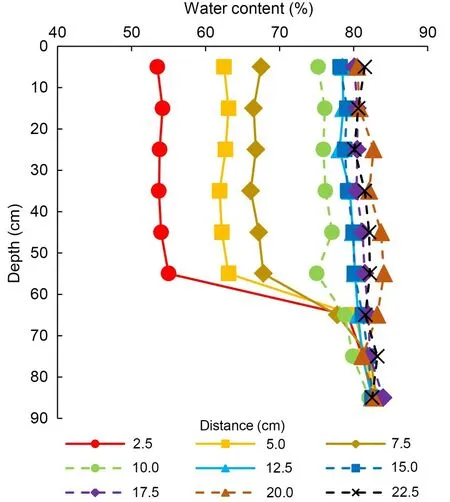
Fig.11 Water content curves of the drainage pipe pile(standing)
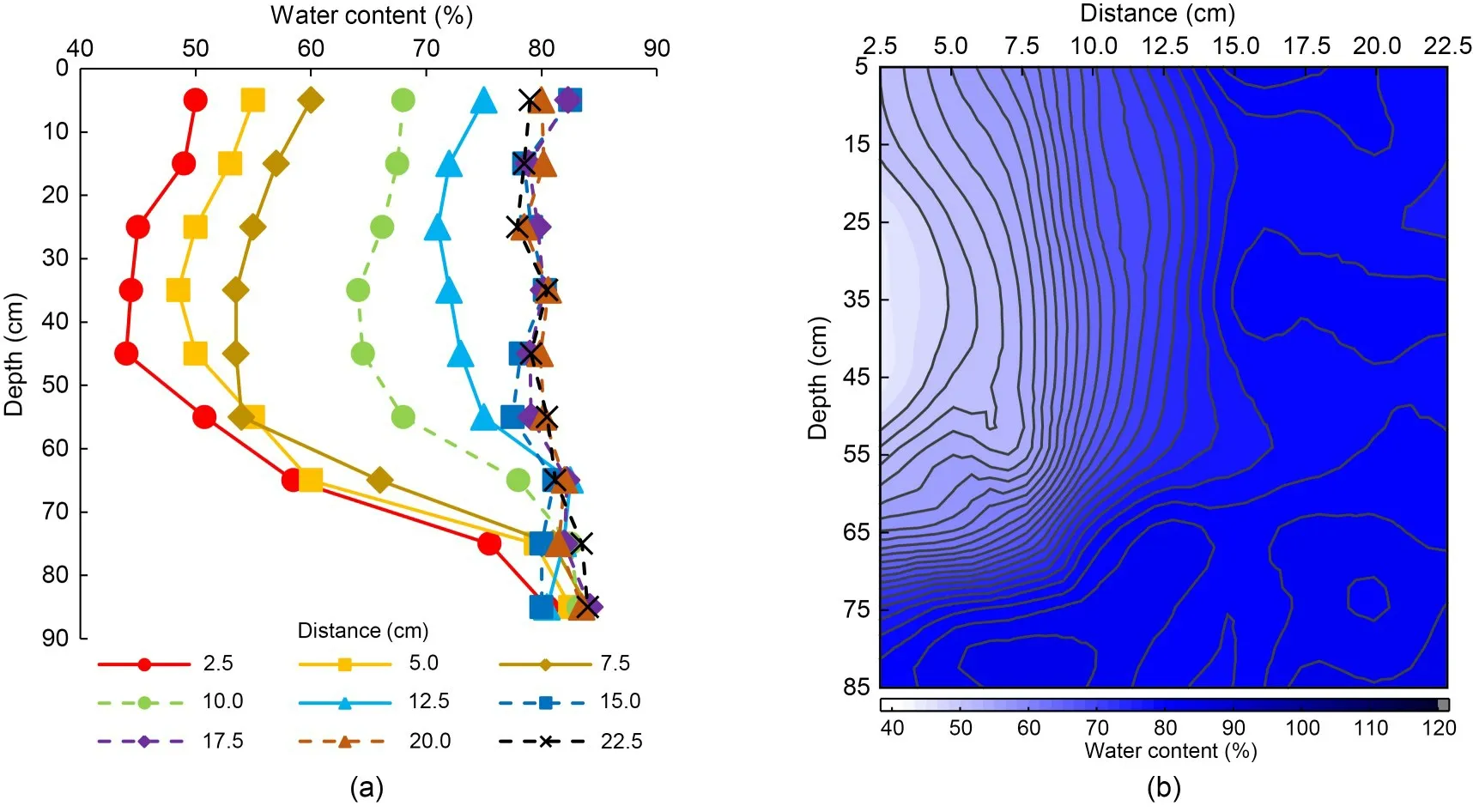
Fig.12 Water content curves(a)and water content cloud chart(b)of the drainage pipe pile(vacuum)
4.5 Analysis of vane shear strength distribution
The vane shear strength curves are shown in Figs.13,14,and 15a.The vane shear strength of soil treated with the perforated pile (standing) and the drainage pipe pile(standing)decreased with increasing depth.For the drainage pipe pile (vacuum),the shear strength of the middle soil was greatly improved due to the effect of vacuum consolidation.The shear strength of the soil 2.5 cm from the pile wall increased nearly 7 times,from 2.0 to 12.5-14.2 kPa.The shear strengths of the perforated pile (standing) and the drainage pipe pile(standing)increased to 6.0-7.0 kPa and 8.0-8.5 kPa,respectively.It seems that anticlogging measures and vacuum consolidation can improve the shear strength of the soil around a pile.Fig.15b shows the vane shear strength in a cloud diagram.The maximum horizontal range of influence of the drainage pipe pile (vacuum) on the shear strength of soil around the pile was 17.5-19.0 cm.The shear strength of the soil around the pile of the drainage pipe pile (vacuum) increased most obviously within the range of 2.5-12.5 cm from the pile wall,and then decreased gradually from 12.5 to 17.5 cm from the pile wall.When it exceeded 19 cm,the shear strength showed no further increase.
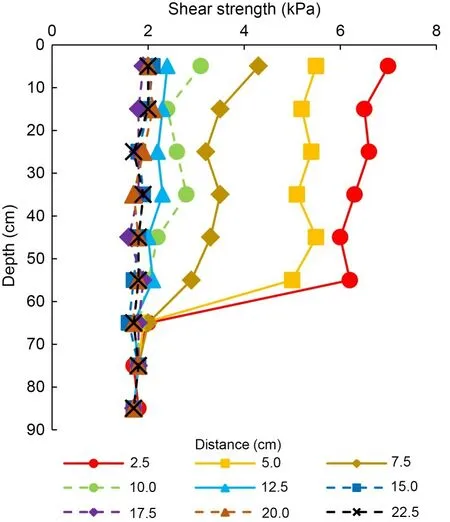
Fig.13 Shear strength curves of the perforated pile(standing)
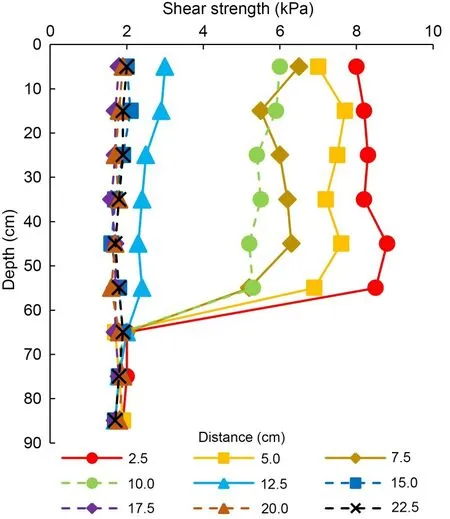
Fig.14 Shear strength curves of the drainage pipe pile(standing)

Fig.15 Shear strength curves(a)and shear strength cloud chart(b)of the drainage pipe pile(vacuum)
As shown in Figs.12b and 15b,when the distance between the soil and the pile wall was greater than 12.5 cm,the shear strength of the soil decreased significantly and the water content increased significantly.When the spacing was greater than 17.5 cm,the shear strength and water content of the soil were consistent with those of non-vacuum consolidated soil.Combining the shear strength and water content data at 12.5 and 17.5 cm obtained in this test,the strong and weak reinforcement areas were defined as follows: the strong reinforcement area was the area where the shear strength increased significantly(4 times in this experiment)and the water content decreased significantly;the weak reinforcement area was the area where the shear strength was greater than that of the non-vacuum consolidated soil and the water content was less than that of the non-vacuum consolidated soil.
In Fig.16,the radius of the drainage pipe pile(vacuum) isr
,the radius of the strong reinforcement area isr
,and the radius of the weak reinforcement area isr
.According to the results of this test,r
=7r
andr
=11r
.This provides a reference for the arrangement of pile groups.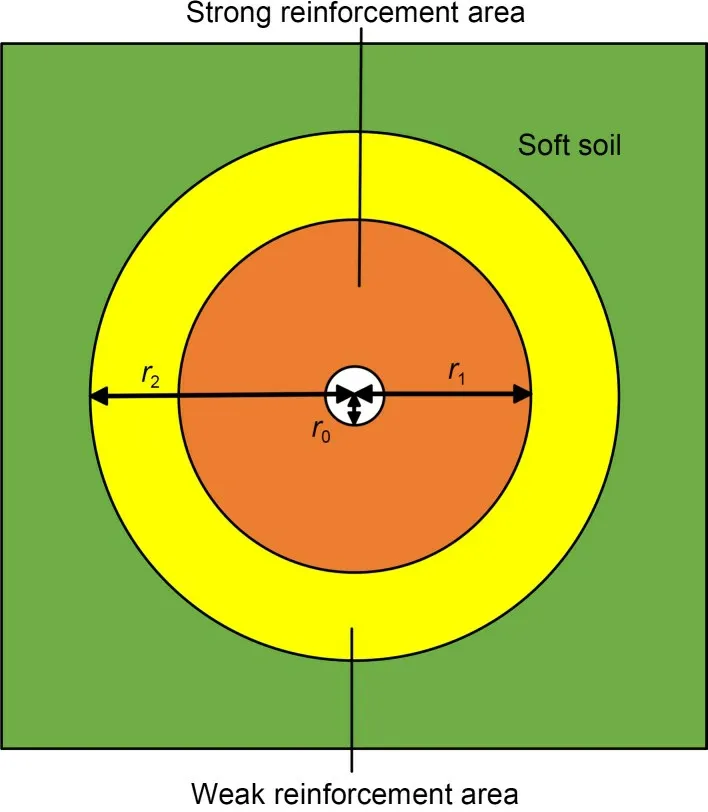
Fig.16 Schematic diagram of the reinforcement areas
Combined with Section 4.1,the significant increase in the vertical bearing capacity of a drainage pipe pile under the action of vacuum can be attributed to two factors.First,due to the accelerated discharge of pore water in the soil around the pile under the action of vacuum negative pressure,the speed of foundation consolidation is accelerated and the shear strength of the foundation is enhanced.Second,with the discharge of pore water,the fine particles in the soil gradually gather near the pile wall,which improves the density of the soil around the pile and has the effect of diameter expansion.
5 Estimating the ultimate bearing capacity of the drainage pipe pile
For piles in a single-layer homogeneous soft soil,the ultimate bearing capacity of a single pile is determined by the total ultimate friction at the pile side and the total ultimate resistance at the pile end.If the ultimate bearing capacity of a single pileQ
is determined according to the shear strength,it can be estimated according to the method suggested by the code:
Q
andQ
are the limit values of side wall friction and end resistance of a single pile,respectively.u
is the perimeter of the pile body;c
is the cohesion between the soil and the pile;l
is the pile length.c
is the average value of the undrained shear strength of the soil in the range from 3d
(whered
is the pile diameter)above the bottom of the pile to 1d
below the bottom of the pile,andc
=αc
.When the ratio of the embedded depthh
to the pile diameterd
is greater than 8 and less than 20,α
is taken as 0.4.N
is the foundation bearing capacity coefficient.When the lengthto-diameter ratio of the pile exceeds 5,N
=9.A
is the area of the pile end.When the shear strength before pile sinking (c
=2.0 kPa) is substituted into Eq.(1),the ultimate bearing capacity of the single pile of the drainage pipe pile is 62.8 N.However,the measured ultimate bearing capacity of a single pile was 271.5 N,which is quite different.For the drainage pipe pile,the soil properties on the side of the pile changed significantly after vacuum consolidation.Therefore,the method suggested by the code is conservative.By substituting the shear strength atr
after vacuum consolidation(c
=13.3 kPa),the ultimate bearing capacity of a single pile is 417.0 N,which exceeds the measured value.This may be because the pile-soil interface is closely bonded due to vacuum consolidation.With the increasing pile top load,the soil at the interface between the strong and weak reinforcement areas takes the lead in shear failure.Therefore,by substituting the shear strength atr
(c
=8.5 kPa),the ultimate bearing capacity of a single pile is 266.9 N,which is close to the measured value.To verify the universality of this conjecture,the pile parameters and the drainage volume were changed.Multiple sets of drainage pipe pile bearing capacity tests were carried out.The conditions of the pile sinking depth,pile diameter,and soil were consistent with those described in Section 4,as shown in Table 4.
Table 4 Comparison of tests and calculation results of ultimate bearing capacity of single pile
Test 1 increased the pumping time,resulting in the largest drainage volume and the largest radius of the strong reinforcement area.Tests 2-6 reduced the layer spacing of small holes and increased the number of layers,which increased the drainage and the radius of the strong reinforcement area.Tests 7-9 changed the aperture of the hole,but had little effect on the drainage volume,so the radius of the strong reinforcement area was almost unchanged.The drainage volume was positively correlated with the radius of the strong reinforcement area.
The results show that,regardless of the size of the pile,the hole type,and the drainage volume,substituting the shear strength of the soil at the interface between the strong reinforcement zone and the weak reinforcement zone into the estimation formula can better predict the ultimate bearing capacity of a single pile.For this laboratory test,the estimated value was less than the actual value,and the error was no more than 15%.This estimation method provides a reference for the estimation of the ultimate bearing capacity of a single pile of a drainage pipe pile in practical engineering.
6 Conclusions
In this study,single pile static load laboratory tests,vane shear tests,and water content tests were carried out on pipe piles,perforated piles,and drainage pipe piles under the conditions of static and vacuum preloading.Based on the tests,the concept of a strong and a weak reinforcement area was proposed and used for predicting the bearing capacity.The conclusions are as follows:
(1) The drainage pipe pile (vacuum) showed no silting.According to the static load laboratory test of a single pile,the bearing capacity of the drainage pipe pile (vacuum) was increased to 271.5 N,compared with 89.5 N of the pipe pile(considering the influence of pile top sealing on the degree of vacuum and the effect of pile spacing on drainage consolidation,this increase may be smaller in actual engineering).On the one hand,the pore water was accelerated to discharge under negative pressure,which enhanced the shear strength of the soil.On the other hand,the fine particles in the soil gradually converged to the pile wall to form a dense soil layer,which had the effect of expanding the pile diameter.
(2) The maximum pile frictional resistance of the drainage pipe pile under vacuum condition was 3-4 times higher than that of the pipe pile.Thedistribution form of frictional resistance was changed.The pile frictional resistance was more developed in the middle and lower parts of the pile.
(3) For the drainage pipe pile (vacuum),strong and weak reinforcement areas were defined according to the distribution of water content and shear strength of soil around the pile.The radius of the strong reinforcement area was positively correlated with the drainage volume.Using the shear strength at the junction of the two areas to estimate the ultimate bearing capacity of a single pile achieved good results.
Acknowledgments
This work is supported by the Key Water Science and Technology Project of Zhejiang Province (No.RB2027) and the Zhejiang Provincial Public Welfare Technology Application Research Project(No.LGG22E080002),China.
Author contributions
Xiao-wu TANG designed the research.Wei-kang LIN and Yuan ZOU processed the corresponding data.Wei-kang LIN wrote the first draft of the manuscript.Jia-xin LIANG and Wen-fang ZHAO helped to organize the manuscript.Weikang LIN and Jia-xin LIANG revised and edited the final version.
Conflict of interest
Xiao-wu TANG,Wei-kang LIN,Yuan ZOU,Jia-xin LIANG,and Wen-fang ZHAO declare that they have no conflict of interest.
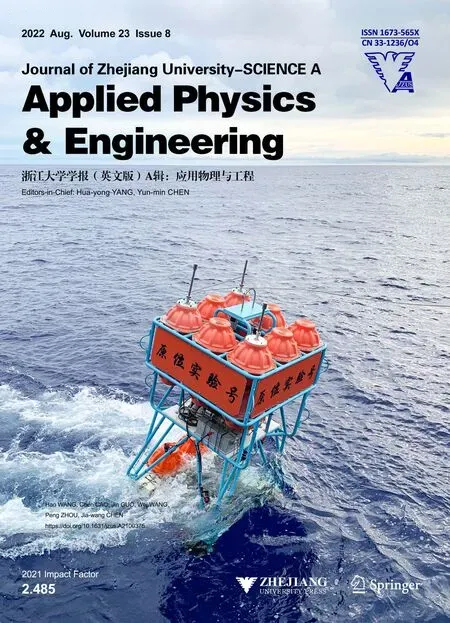 Journal of Zhejiang University-Science A(Applied Physics & Engineering)2022年8期
Journal of Zhejiang University-Science A(Applied Physics & Engineering)2022年8期
- Journal of Zhejiang University-Science A(Applied Physics & Engineering)的其它文章
- Copyright Information
- Activeflow co ntrol of S-duct by plasma synthhetic jet
- Active flow control of S-duct by plasma synthetic jet
- How fast is it to city centers?The average travel speed as an indicator of road traffic accessibility potential
- Effects of moisture content and dry bulk density on the thermal conductivity of compacted backfill soil
- Flow control characteristics of the digital and mechanical redundancy control electric modulation valve
